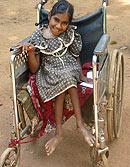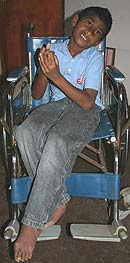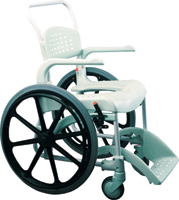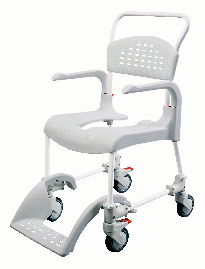
|
|||||||||||
|
| |||||||||||
|

|
| Etac Clean 24 wheelchair |
| Etac Clean wheelchair |
| Etac Clean Height Adjustable wheelchair |
 |
Wheelchairs are a necessary item for many people. They provide mobility to people who might otherwise be unable to travel. For some people they are temporary, like those recovering from a recent surgery or injury. They need something simple that will get them around until they heal.
But for people who have a long-term need for a wheelchair, a simple model with minimal frills just won't cut it. There are different types of wheelchairs though, and knowing which is best for a particular person is crucial.
The first record of a wheelchair being used is on a stone slate in China. The image of a person in a wheelchair-like device dates back to the 6th century. There are other records of them being used in Europe as early as the 15th century.
Being such a novelty, early wheelchairs were reserved almost entirely for nobility. They were the only ones who could afford the costs, as well as being the only ones with households large enough to make owning a wheelchair a practical idea. There were no paved streets at that time, and the average house was a meager room or two, hardly something you'd need a mobile chair to navigate.
Wheelchairs slowly became more common as the centuries passed. Self propelled wheelchairs are models that can be pushed by the person seated in them, rather than by someone behind the chair. The first such wheelchair that we know of was created in 1655 by a 22 year old watchmaker with paraplegia.
The predecessors of the modern wheelchair evolved from the late 1800s through the early 1900s. Self-propelled wheelchairs started becoming more common when the push-rim was designed around 1880. Metal spokes began to replace wooden ones around 1900 as well. The wheelchair was still unwieldy, but it was making improvements in the right direction.
Motorized wheelchairs started being produced in 1916, and in 1933 the first foldable wheelchairs made the scene. During the 1970s is when wheelchairs really started resembling what we know today. They switched to aluminum, making them lighter weight, and they were made more adjustable.
Today there are many types of wheelchair available for purchase. Even with all the fancy types available, self-propelled are still the most common. These allow disabled persons to maintain their independence, and are also a great way for someone to keep up their upper-body strength, stay fit, and exercise.
Electric wheelchairs are convenient for those who may not be able to utilize a traditional wheelchair. There are simple electric wheelchairs that help people such as elderly folks get from place to place, and there are also complex ones for people who have more than just mobility problems.
While mobility is the main focus of a wheelchair, much thought must be put into comfort as well. A person will spend many waking hours in this device, so the goal is to make them as pleasant as possible.
For this reason materials that provide the most comfort and durability are picked for these chairs. This is particularly important for those who have to be in wheelchairs for a long time, but even people who only need the wheelchair for a short time shouldn't be uncomfortable.
With the advances in wheelchairs, more recreation options for people who require them have become available. There are many sports that have either been modified to allow for people in wheelchairs to make teams and play, or that have been created specifically for people in wheelchairs. Racing is probably the most common of these, and special racing wheelchairs are made to be super-light and aerodynamic.
Wheelchairs have come a long way since they were first invented, and advances continue to be made. This makes it continually easier for disabled individuals to lead the full lives that every person deserves.
Article Source: EzineArticles.com/2556531
Other mobility solutions |


